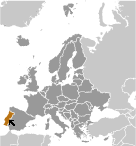World Atlas: Portugal. On this page you can see the map, country flag and many detailed information about the people, history and economy of Portugal.

Here you can find online selected information about the geography, inhabitants, government, economy and history of Portugal. Included are selected statistics, an overview map and the detailed map of Portugal. But let's start with the flag of Portugal here:
Portugal - Overview:
What you should know about Portugal? Let's start with this: Following its heyday as a global maritime power during the 15th and 16th centuries, Portugal lost much of its wealth and status with the destruction of Lisbon in a 1755 earthquake, occupation during the Napoleonic Wars, and the independence of Brazil, its wealthiest colony, in 1822. A 1910 revolution deposed the monarchy; for most of the next six decades, repressive governments ran the country. In 1974, a left-wing military coup installed broad democratic reforms. The following year, Portugal granted independence to all of its African colonies. Portugal is a founding member of NATO and entered the EC (now the EU) in 1986.
Geography of Portugal
 Where on the globe is Portugal? The location of this country is Southwestern Europe, bordering the North Atlantic Ocean, west of Spain. Total area of Portugal is 92,090 sq km, of which 91,470 sq km is land. So this is not a large country. How could we describe the terrain of the country? This way: the west-flowing Tagus River divides the country: the north is mountainous toward the interior, while the south is characterized by rolling plains. The lowest point of Portugal is Atlantic Ocean 0 m, the highest point Ponta do Pico (Pico or Pico Alto) on Ilha do Pico in the Azores 2,351 m. And the climate is maritime temperate; cool and rainy in north, warmer and drier in south.
Where on the globe is Portugal? The location of this country is Southwestern Europe, bordering the North Atlantic Ocean, west of Spain. Total area of Portugal is 92,090 sq km, of which 91,470 sq km is land. So this is not a large country. How could we describe the terrain of the country? This way: the west-flowing Tagus River divides the country: the north is mountainous toward the interior, while the south is characterized by rolling plains. The lowest point of Portugal is Atlantic Ocean 0 m, the highest point Ponta do Pico (Pico or Pico Alto) on Ilha do Pico in the Azores 2,351 m. And the climate is maritime temperate; cool and rainy in north, warmer and drier in south.
Inhabitants of Portugal
Let's take a look how many people live in Portugal. The number is: 10,839,514 (July 2017 est.). So this is not very populous country. Who lives here? homogeneous Mediterranean population; citizens of black African descent who immigrated to mainland during decolonization number less than 100,000; since 1990, East Europeans have entered Portugal. What are the languages in Portugal? Portuguese (official), Mirandese (official, but locally used). And the religions: Roman Catholic 81%, other Christian 3.3%, other (includes Jewish, Muslim, other) 0.6%, none 6.8%, unspecified 8.3%. How old are the people in average? 42.2 years. We have to add that this number is the median - so one half of the people is older than this, one half is younger. And what is their life expectancy (at birth)? This: 79.4 years. Where the people live in Portugal? Here: concentrations are primarily along or near the Atlantic coast; both Lisbon and the second largest city, Porto, are coastal cities. The major urban areas of Portugal are: Lisbon (capital) 2.884 million; Porto 1.299 million (2015).
Government and Economy of Portugal
The capital of Portugal is Lisbon and the government type semi-presidential republic. Let's take a look at the administrative divisions - 18 districts (distritos, singular - distrito) and 2 autonomous regions (regioes autonomas, singular - regiao autonoma); Aveiro, Acores (Azores), Beja, Braga, Braganca, Castelo Branco, Coimbra, Evora, Faro, Guarda, Leiria, Lisboa (Lisbon), Madeira, Portalegre, Porto, Santarem, Setubal, Viana do Castelo, Vila Real, Viseu. Regarding the economy of Portugal, important industrial products are textiles, clothing, footwear, wood and cork, paper and pulp, chemicals, fuels and lubricants, automobiles and auto parts, base metals, minerals, porcelain and ceramics, glassware, technology, telecommunications; dairy products, wine, other foodstuffs; ship construction and refurbishment; tourism, plastics, financial services, optics. Important agricultural products are grain, potatoes, tomatoes, olives, grapes; sheep, cattle, goats, pigs, poultry, dairy products; fish. The most important export commodities are agricultural products, foodstuffs, wine, oil products, chemical products, plastics and rubber, hides, leather, wood and cork, wood pulp and paper, textile materials, clothing, footwear, machinery and tools, base metals and the most important export partners are Spain 26.2%, France 12.6%, Germany 11.7%, UK 7%, US 4.9% (2016). The most important import commodities are agricultural products, chemical products, vehicles and other transport material, optical and precision instruments, computer accessories and parts, semiconductors and related devices, oil products, base metals, food products, textile materials and the most important import partners are Spain 32.8%, Germany 13.5%, France 7.8%, Italy 5.5%, Netherlands 5.1% (2016). How rich is Portugal and how rich are people in this country? The most important number here is GDP per capita (PPP): $30,300 (2017 est.). This means the living standards are good here. Let's add that this means Gross Domestic Product per person, which is recalculated with respect to the relative cost of local goods and services. And one more important number - population below poverty line: 19% (2015 est.).